These are those moments of leaving the hotel lobby through a revolving door, and diving into the city's air, that make me feel like being in another world in Ho Chi Minh City.
My luggage has then been unpacked in my room, the laptop gets its power recharge, I might have just taken a shower after a whole day flight and decided to look around. And then it comes – with one step outside I am in this warm, humid, nearly tangible air, full of various smells and sounds, so different from the air in all the large cities of Europe.
In such moments, I keep recalling the talk with a passenger next to me on a flight many years ago. "First time to Asia?", he asked. I nodded and he smiled as if wanting to say that there was no way I could imagine what was I was about to experience there. Something like "Friend, you are now going to learn the real world". He was right. Of course, you must make yourself open to what you see, hear, touch, and smell. But when you do, it will teach you a lot. It may even change you.
I have made many travels to Asia since then and it did change me.
Openness of river deltas
The delta regions of large rivers may possibly be the places where water moves slowly but life, to the contrary, moves fast. Ho Chi Minh City, or HCMC for short, does not exactly lie in the Mekong Delta, but in the close proximity of it. This largely determines the economy and the life style of the city. I am convinced that it also determines the character of its population of about 9 millions.
Why?
Well, people of all delta regions seem to be - like their land - open.
Open to about everything that comes along. I have observed this in the Netherlands, some other coastal regions in Europe, in the Mississippi River Delta in the USA and, apparently, also in the wide region of the Mekong Delta including HCMC.
In addition, this city is the heart of one of the fastest growing economies in Asia. As one of my Vietnamese fellow-engineers said, "Hanoi is our cultural capital, HCMC is the economic capital". You, indeed, see the dynamics of this economic growth everywhere. For example in the area of the Muong Chuoi Barrier in the South of the city, where the rapidly arising new infrastructure and still traditional supplies of goods go hand in hand with each other.

Yet, every time that I visit this city, it takes a while to catch up with its style and dynamic growth. As if there is too much of openness there for a European to step into. Back in 2009 when Vietnam was not yet fully discovered by the western tour operators, the scenes at HCMC's Ben Thanh Market and the neighboring quarters showed an immersive, sharp reflection of the country's life. The reflection that one might not be prepared to contemplate.
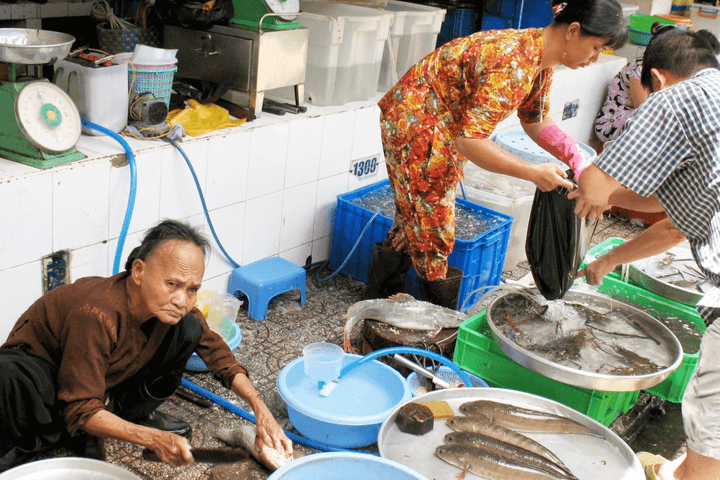
It is not easy to describe this openness. Perhaps one example will do instead:
It was in the evening. My colleague Erwin and I went down the street to have a dinner. We saw a river in the distance, so we hoped to find a place with a terrace close by water, which would offer some cooling in the hot, humid air of this city. It took some time, but we got there. Unfortunately, it appeared not to be a river but an open sewage. We then turned back the same way and took one of the side streets just at random.
There we found a small, quiet eatery with a terrace. We set down, got our ba-ba-ba beers (Vietnamese pronunciation of the local "333" beer) with ice, which is the Vietnamese way of drinking beer, and waited for the ordered food. A young woman with a basket emerged from nowhere. She wanted to sell us some flowers. She had only a few small, not particularly impressing bouquets, she spoke good English and was – like more Asian sellers – quite insistent:
- Look gentlemen, beautiful flowers. Please buy flowers for your ladies.
- No, thank you very much – I said.
- What do you mean "no"? Flowers are beautiful, your ladies will love them.
- Our ladies are not with us, we are on a business trip here.
- Business trip – oh, I see. Well, flowers are good for business too, they will make your business more pleasant. They may bring you good luck.
- No, look lady, we really don't need your flowers.
This would normally end the discussion. But then there happened something that changed the game. And it also changed me. At least, I hope it did. The women looked at me seriously, waited a moment and said:
- But I really need your money.
There was no answer to that. Erwin and I bought a bouquet, both paying some 10,000 Vietnamese Dongs for it, which might then be worth about 1 US dollar. The point that this woman made was, in a way, shocking. It was not from the world of business that I had known for long, it was not from any world that I had ever known – and yet it was so powerful and clear.
I recalled the smiling face of that chap from the plane, who years before had asked if it was my first time to Asia. Well, it was not anymore, but one keeps learning. OK, I am not going to moralize here; I hope you understand.
Extraordinary vitality
Openness of river deltas, and of Ho Chi Minh City in particular, is not the only feature that strikes the visitor there. The other feature is an extraordinary vitality. I am even not sure if it is right to call it "other" feature. Openness and vitality seem to fit seamlessly together.
Most of you might have seen the photos of streets full with motorbikes, so characteristic for this city. The first what comes to mind then is a concern whether all these people will still safely come home. Eventually they will. Moreover, I have never tried riding a motorbike in HCMC, but I spoke with several Europeans who had done this; and they assured me that it goes – to quote one of them – "quite naturally".
You are becoming absorbed by a river of similar bike riders and you simply become one with this river. Well, after some training, I suppose.
The vitality of the HCMC's streets is what you do not only see on the traffic lanes. It demonstrates itself even stronger on the sidewalks. There is incredibly much happening on these sidewalks, so much that it makes the visitor feel like stepping into people's lives. The Saigonese do not only socialize and recreate on the sidewalks; they also do crafts and business there, they prepare their meals, cook, eat, wash, play, receive all kinds of care, and so on.
You may, in the first instance, feel like an intruder there, but there is absolutely no reason for that. To the contrary, any contact is welcome. Most welcome are, of course, the contacts that lead to buying something, but a simple interest or friendly chat will usually be appreciated too.
A few words Vietnamese, even if only hello (xin chao), help enormously. Do not worry, they won't expect you to know their language – your whole appearance makes is clear that you do not. What this will tell them is that you have taken some interest in their culture. And that is a lot.
I am not a social beast, but I was lucky that some of my travel companions were. So, while they were having simple chats, I felt excused to make pictures of Ho Chi Min City's sidewalk life. Below is a short selection. While viewing them, try to also imagine that hot air with its exotic smells and noises, the air described in the first paragraph of this story.




Keeping the city dry
As you can see, the HCMC's walkway pavements are good for many purposes.
But then they must remain dry. And this is, unfortunately, an issue with as a result that the city gets frequently flooded. This happens for a number of reasons, the most challenging of which are:
- Spring tides entering the city through the Sai Gon River, Dong Nai River and – to lesser extent –Vam Co River, see map;
- Storms and storm rains, especially during high tides;
- Recurrent monsoon flooding in the Mekong Delta;
- Sea level rising due to the climate change;
- Anthropogenic (man-made) causes, like uncontrolled urban growth, overloaded drainage and sewage systems, Mekong dams that reduce sediment deposition etc.;
- Various combinations of the above.
A complex problem indeed. The problem that, obviously, also requires complex solutions. My involvement in keeping HCMC dry was probably an effect of the good reputation that the Dutch engineers enjoy in this field. It began in 2009, with a three weeks long consulting assignment in this city; and continued later on an ad-hoc basis through either the Dutch Government or the Belgian University of Liège.
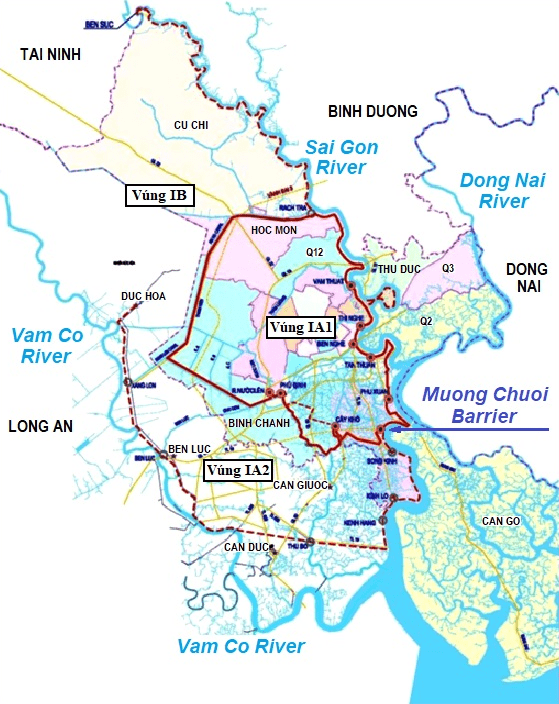
I could not, of course, contribute to mitigating all the reasons for floods. Nobody can. My expertise was limited to the design and construction of movable dams and flood protection systems.
So, this is what I mainly talked about with my Vietnamese colleague-engineers, trying to share as much of my experience as possible – and learning from their experience. But one cannot actually separate the issues when it comes to flood protection. One also should not, I think.
At such points, I must think about a verse from a poem "Terrible burghers" by Julian Tuwim – a poem that I learned at school in my birth country Poland:
And there they go, tightly buttoned,
They look to the right, look to the left.
And when looking – they see everything apart
That house… that man… that horse… that tree…
Well, we should better not be "terrible burghers". So, when accepting that I may not be qualified enough to correctly assess other than technical issues, I do try to understand them at least.
The one that cost me some effort was that the Vietnamese colleagues actually liked to have kind of "multi-purpose" flood barriers, i.e. structures that would not only keep the flood water away. They should also help manage the water levels in the city, facilitate the drainage in rainy seasons, agriculture on the city's outskirts, clean-ups in case of sewage failures, etc.
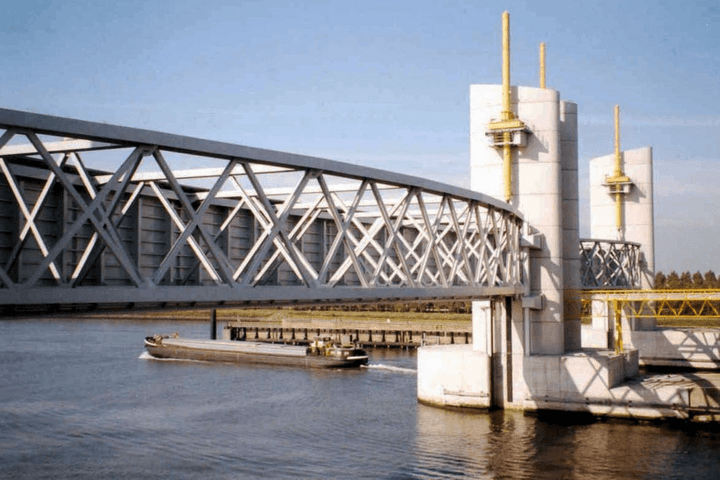
This was something quite different than, for example, the Hartel Canal Barrier near Rotterdam, with its lenticularly shaped vertical lift gates, of which I was the lead designer. Those gates were there only for the case of an extreme storm surge; and were supposed to close once in a number of years, disregarding the test closures.
The expected utilization of the HCMC's flood barriers was – in a sense – similar to that of the city's sidewalks, which were there also for much more than only walking.
What appeared to help, was the topic that I had been asked to research a few years before for the Working Group of PIANC, the World Association for Waterborne Transport Infrastructure. That Group was dealing with "Movable Weirs and Storm Surge Barriers" and my topic was the so-called "Multi-Criteria Analysis". This is a set of methods to arrive at well-balanced choices of technical solutions to, in this case, river weirs or flood barriers.
What we then had in mind, was combining the interests of flood defense, navigation, operation and maintenance in a single structure. However, expanding this with more criteria, like drainage and agriculture, was not such a problem. Of course theoretically, as the practice always remains complex. But the theory helps too.
So, there we went! This was, in fact, one of my most fruitful sessions with the Vietnamese colleague-engineers. We all felt as getting down to the heart of the matter. We took the Muong Chuoi Barrier project – then still in concept stage – as the case study. It was one of the largest and most centrally located flood barrier projects in the city.
First, we set a number of potentially feasible ideas for this barrier on paper; and we defined all relevant "assessment criteria". Then we gave these criteria so-called "weighting factors" because, for example, the reliability of flood protection weighs, normally, more than aesthetics. At least, that was what we thought.
We worked out our optional ideas, still very globally and largely based on so-called "engineering judgments", receiving comparable data, and arriving at the choice for a barrier with four gates of a vertical lift type, each 50 meters wide. The gates were to be comparable to those of the Storm Surge Barrier in the Ems River, Germany. This was, of course, a training session. The definitive choices were to be taken later, based on more data and more studies. Yet, everybody felt happy and inspired.
Special moments
I did not hear much about this or other barrier projects in HCMC for some time, until – 9 years later – I was asked to come again. This time only for a few days as part of an international workshop held together by the Vietnamese Institute for Water and Environmental Research (IWER), and the Belgian University of Liège. The workshop began in HCMC, and was concluded in Can Tho, the largest city of the Mekong Delta. It was the latter where my main contribution was desired this time. I was supposed to deliver a presentation and answer questions about another type of flood barriers, one of which was just being designed for that city.
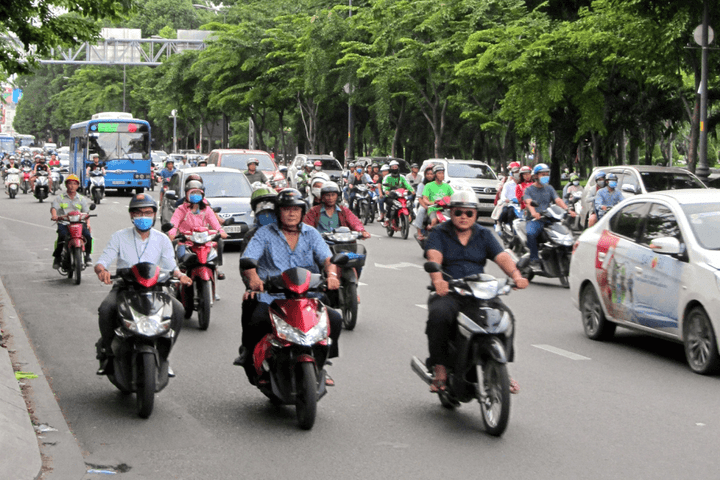
But first a couple of days back in HCMC. Again the same tangible air, the same multifunctional sidewalks, and the rivers of motorbikes – only this time interspersed with more cars. The organisers enriched the workshop with a visit to the construction site of one of the city's flood barriers.
To my delight, it was the Muong Chuoi Barrier, the one from our case study of the Multi-Criteria Analysis from 9 years earlier. The site was in the last stage of construction. The lifting towers did not carry the gates yet but all the concrete structures were already erected and free of formwork. It was indeed a vertical lift gate barrier.
Moreover, the contours of the towers clearly indicated that the gates were to be driven up and down by hydraulic cylinders – exactly as foreseen in our case study. There were more similarities like that. For example, a search on Internet will reveal that the gates, installed in January 2021, are shaped in a way comparable to the German Ems Barrier, also as assumed in our study.
But there were also indications that various details and aspects received individual, thorough care of the designers. This included the aesthetics, which we had given the lowest weighting factor back in 2009. The HCMC's Muong Chuoi Barrier is clearly a beautiful structure, which can be seen today on Internet or on a visit to that site.
Obviously, observations like this make engineers happy. Even if our own contribution is not that large. But there is more here to be happy about. This is that the Vietnamese colleague-engineers are really proud of this structure. I stood among them on the deck of a navigation lock that also makes part of the Muong Chuoi site – my tall Dutch body towering above their heads – and I felt their joy and excitement.
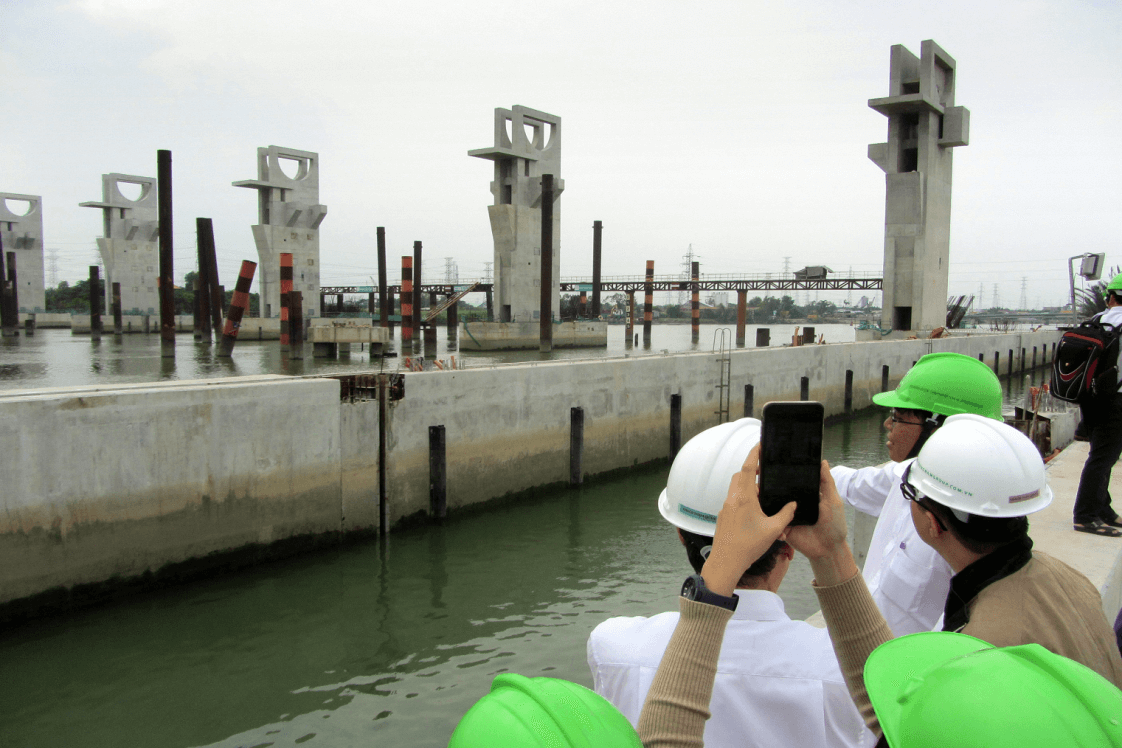
These were special moments, for them and for me.
Allow me still one reflection:
Some analysts say that we are entering the age when another continent – yes, Asia – is going to take the leadership of this planet over from the so-called "West". I am not an economist, neither a futurist, but I indeed saw a great potential on that continent. An impressing potential and not only in Vietnam. On the other hand, there is little reason to be particularly proud of the western leadership of the world these days.
Well, be my guest Asia – do take it over.






